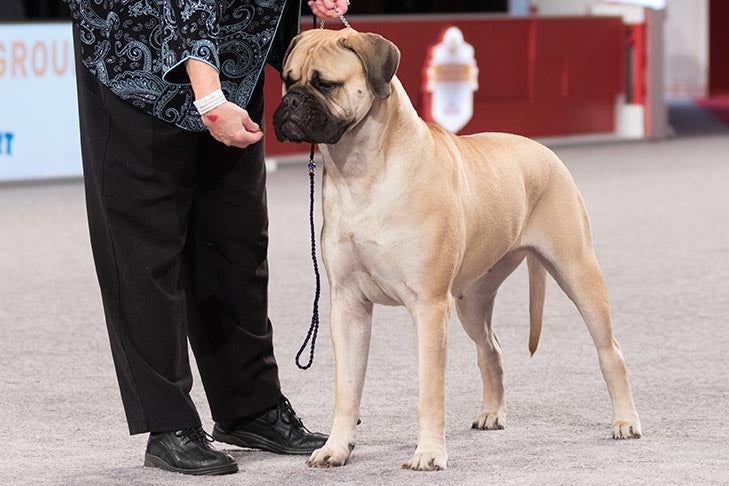
Majestic. Massive. Muscular. Mastiffs are among some of the oldest breeds known to humans. They feature in legend, as well as recorded history, and were among the first canines to accompany humans on their migrations across the globe. The mastiff family is full of powerful breeds, each with its own unique personality.
Mastiffs have been used as guard dogs, war dogs, and fighting dogs throughout the ages. Today, many of them reside in our homes as beloved members of our families, but they still take their jobs as family protectors seriously.
Owning a mastiff is a responsibility as large as the dogs themselves. Learn more about the Bullmastiff, Mastiff, Neapolitan Mastiff, and Tibetan Mastiff, and see if they might be right for you and your family.
Bullmastiff

The Bullmastiff is an intelligent, brave, affectionate, and highly loyal dog. The Bullmastiff was bred in England from Bulldogs and the Old English Mastiff in the 1860s to help gamekeepers protect estates and game preserves against poachers. Unlike other guardian breeds, Bullmastiffs are relatively quiet, relying on their size, strength, and reputation to deter intruders.
These massive canines mature between 100 and 130 pounds, with males averaging at 120 pounds and 26 inches tall. Like their close relative the Mastiff, Bullmastiffs have a black face mask. The accepted colors in the breed standard are fawn, red, and fawn-and-red brindle, and they have powerful, athletic bodies.
Mastiff

This courageous canine can trace their roots back to ancient civilizations in Egypt and Rome. Caesar himself described a dog similar to the Mastiff in his accounts of invading Britain in 55 B.C.
Historically, Mastiffs were used as guard dogs and as fighting dogs. Their bravery, dignity, and strength made them popular with the nobility of ancient Rome, and they were frequently pitted against human gladiators, bears, bulls, lions, and tigers. Mastiffs come in apricot, brindle, and fawn coloring with a black mask and can weigh anywhere from 120 to 230 pounds, but despite their warrior pasts, Mastiffs are generally good-natured, peaceful family-oriented dogs.
Neapolitan Mastiff

Neapolitan Mastiffs are unmistakable. With their distinctive, wrinkly skins and impressive jowls, these Italian dogs can trace their roots back to Roman dogs of war. In Italy, they were used to guard estates, where their large size, weighing in at over 150 pounds, kept out all but the most determined—or foolish—intruders.
Neapolitan Mastiffs come in black, blue, mahogany, brindle, and tawny coloring, and are naturally watchful, dignified, and loyal companions. Like all mastiff breeds, they require training and socialization at a young age to help them master their protective instincts.
Tibetan Mastiff

Tibetan Mastiffs are a breed unto their own. These massive, heavy-coated mountain dogs are large, notoriously independent, reserved, intelligent, and highly protective.
This is not a dog breed for everyone. They take a special kind of owner willing to devote the time and patience required for extensive training. Independent dogs, Tibetan Mastiffs have minds of their own. As one owner puts it, “They want to be with you. It’s just that they think that if they’re in the same country, they are with you.”

